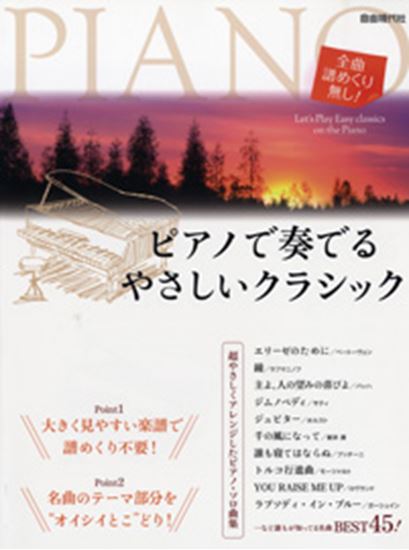Prokofiev, Sergei Sergeevich : 10 Pieces from 'Romeo and Juliet' Op.75
Work Overview
Instrumentation:Piano Solo
Genre:pieces
Total Playing Time:35 min 00 sec
Copyright:Public Domain
Commentary (1)
Author : Nohara, Yasuko
Last Updated: February 1, 2008
[Open]
Author : Nohara, Yasuko
Ballet Romeo and Juliet (1936) is one of Prokofiev's most widely beloved masterpieces, based on Shakespeare's tragedy Romeo and Juliet. From this ballet, Prokofiev created three orchestral suites and Ten Pieces for solo piano. Ten Pieces (1937) was premiered by Prokofiev in the year of its composition. These pieces are re-arranged selections from the original ballet score, chosen for their suitability for transcription, and, like the orchestral suites, are not arranged in the order of the ballet's plot.
No. 1. Folk Dance Allegro giocoso
Music from the beginning of Act II of the ballet (No. 22), depicting a lively carnival scene in the town square. A vibrant dance (tarantella) theme is sung with a dynamic rhythm in 6/8 time.
No. 2. Scene Allegretto
Music from Act I of the ballet, depicting the awakening of the town (No. 3). The scene of the sun rising and the town coming to life is depicted through variations of a light and bright melody in 2/4 time.
No. 3. Minuet Assai moderato
Music from Act I, Scene 3 of the ballet (No. 11), depicting guests invited to the Capulets' ball successively entering the hall. A splendid minuet theme in B-flat major is repeated, interspersed with trios that suggest various characters.
No. 4. Young Juliet Vivace
Music from Act I, Scene 2 of the ballet (No. 10), depicting Juliet's entrance. The mischievous melody at the beginning is central, alternating with a beautiful melody in A-flat major (Juliet's theme heard in the ballet's opening prelude) and a quiet, longing melody (Piu tranquillo), conveying the multifaceted charm of the young girl.
No. 5. Masks Andante marciale
Music from Act I, Scene 3 of the ballet (No. 12), depicting Mercutio inviting his friends Romeo and Benvolio to don masks and infiltrate the ball at the enemy Capulet household. The cheerful and cynical Mercutio and the audacious young men are vividly portrayed through witty variations of a march-like melody.
No. 6. Montagues and Capulets Allegro pesante
Music from Act I, Scene 4 of the ballet, the ball scene (No. 13). The dominant, weighty, and imposing melody in this scene is the dance music of knights and ladies. In the middle section (Moderato tranquillo), an extremely beautiful and sentimental melody is heard as Juliet dances with Paris, the young man her parents are urging her to marry.
No. 7. Friar Laurence Andante espressivo
Music from Act II, Scene 2 of the ballet (No. 28), depicting Romeo seeking out Friar Laurence and confessing his love for Juliet. Laurence promises to officiate their wedding, secretly hoping that this will put an end to the feud between the Montagues and Capulets. The warm melody, played by cello and oboe in the ballet, reflects Laurence's benevolent character.
No. 8. Mercutio Allegro giocoso
Act I, Scene 4 of the ballet (No. 15). Cheerful and witty music from the scene where Mercutio bursts into the ball and dispels the solemn atmosphere with his joyful dance.
No. 9. Dance of the Girls with Lilies Andante con eleganza
Delicate and melancholic music from Act III, Scene 3 of the ballet (No. 49), depicting the scene on the morning of Juliet and Paris's planned wedding, where the daughters of Antilles dance with lilies in hand, unaware that Juliet lies in a death-like trance in her bedroom.
No. 10. Romeo and Juliet Before Parting Lento
Begins with music from Act III, Scene 1 of the ballet, depicting Romeo and Juliet affirming their love in the quiet of the night in Juliet's bedroom, and Romeo's departure (Nos. 38 and 39). In the Adagio (from measure 50), a dramatic melody is sung from the scene (No. 43) where Juliet, driven to despair by her parents' insistence on her marriage to Paris, goes to seek Friar Laurence's help. The quiet Andante (from measure 71) that concludes the entire piece is music from the scene where Juliet, following Friar Laurence's advice and determined to remain true to her love for Romeo, drinks the potion to feign death and deceive those around her. Juliet's hesitation, anxiety, and the scent of death are fantastically depicted.
Movements (10)
"Arrival of the Guests" Op.75-3
Total Performance Time: 3 min 00 sec
"Montagues and Capulets" Op.75-6
Total Performance Time: 3 min 30 sec
"Dance of the Girls with the Lillies" Op.75-9
Total Performance Time: 2 min 00 sec
"Romeo bids farewell to Juliet" Op.75-10
Total Performance Time: 8 min 30 sec
PTNA & Partner Channel Videos(11items) View More
Reference Videos & Audition Selections(4items)
Sheet MusicView More
Scores List (19)

(株)音楽之友社

KMP(ケイ・エム・ピー) ケイエムピー

(株)リットーミュージック

ハンナ(ショパン)

(株)ヤマハミュージックエンタテインメントホールディングス

(株)シンコーミュージックエンタテイメント

(株)ドレミ楽譜出版社

(株)シンコーミュージックエンタテイメント

KMP(ケイ・エム・ピー) ケイエムピー

(株)ドレミ楽譜出版社

(株)シンコーミュージックエンタテイメント

(株)シンコーミュージックエンタテイメント

(株)シンコーミュージックエンタテイメント

(株)自由現代社

(株)ドレミ楽譜出版社

(株)ヤマハミュージックエンタテインメントホールディングス


















